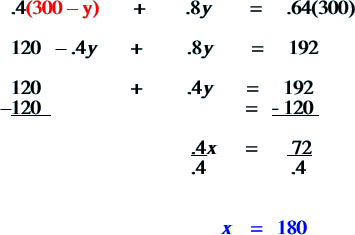EEK! Mixture Problems! These common algebra problems confuse the heck out of everyone. I think the reason for the confusion is because books teach it using just one variable. It is SO much easier when solved with TWO variables. Seriously! Check it out… Here's a typical mixture problem:
How do you go about solving it? Let's think of it like this: |
||
|
||||||||||||||||||||||||||||||||||||||||||||||||||||||||||||||||||||||||||||||||||||||||||||||||||||||||||||||||||||||||||||||
In order to begin solving the equation, we need to do a bit of work…we have two variables so this is kind of crazy, right? We can easily make a substitution so let's say we solve for y. |
||
 |
||||
Here we solved for x. |
||||
Now, just simply substitute the value for x (the 300 – y) for the x in the equation as follows: |
||
 |
||
Go back and substitute your x value into the original equation… |
||
 |
||
So, you can now answer the question! Kyle needs 180 liters of the 40% and 120 liters of the 80% solution! Yahooo! |
||
©2011–2017 Sherry Skipper Spurgeon. All Rights Reserved. |
||


